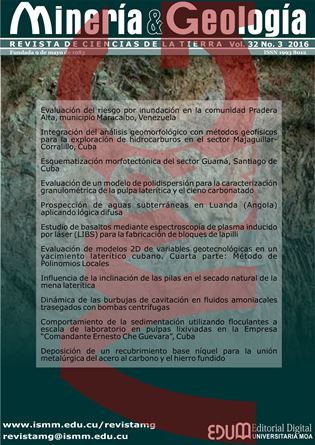Groundwater Prospecting in Luanda (Angola) with the Application of Fuzzy Logics
Keywords:
fuzzy logic, water prospecting, groundwater, hydrological mapping.Abstract
This study is aimed at obtaining a map for groundwater prospecting in the province of Luanda (Angola) applying fuzzy logic. A favorability map was generated by integrating six variables (longitudinal conductance, delta H, digital elevation model, geological map, static elevation and apparent resistivity and using ArcSDM extension of Sig ArcView with gamma operator and index ϒ=0,7. This map made it possible to classify the province into three areas: less favorable, favorable and very favorable for prospecting for underground aquifers.Downloads
References
COX, E. 1994: The fuzzy systems handbook: a practitioner’s guide to building, using, and maintaining fuzzy systems. AP Professional, New York.
ESRI 2002: ARCVIEW Gis 3. 3. Copyright © Environmental Systems Research Institute, Inc.
KEMP, L. D.; BONHAM-CARTER, G. F.; RAINES, G. L. & LOONEY, C. G. 2001: Arc-SDM: ArcView extension for spatial data modelling using weights of evidence, logistic regression, fuzzy logic and neural network analysis. Disponible en: http://ntserv.gis.nrcan.gc.ca/sdm/default_e.htm.
KUMAR, U.; KUMAR, B. & MALLICK, N. 2013: Groundwater Prospects Zonation Based on RS and GIS Using Fuzzy Algebra in Khoh River Watershed, Pauri-Garhwal District, Uttarakhand, India. Global Perspectives on Geography (GPG) 1(3), August.
ZADEH, L. A. 1965: Fuzzy Sets. Information and Control 8(3): 338-353.
MAGALHÃNES, A. S.; MORAIS, J. P. & COLOMBO, E. M. M. 2009: Plataforma sig: investigaçoes geolectricas para a prospecçao hidrogeologica na provincia de Luanda. Tesis de diploma. Universidad Agostinho Neto, Angola.
MIGUEL, G. L. 2001-2002: Sistema Aquífero Quelo, Luanda.
MONJEZI, N.; RANGZAN, K.; TAGHIZADE, A. & NEYAMADPOUR, A. 2013: Site selection for artificial groundwater recharge using GIS and Fuzzy logic. International Journal of Engineering & Technology 1(5): 294-309.
FERNÁNDEZ-NÚÑEZ, H. M. 2006: Metodología para cartografiar la influencia de factores geoambientales en la distribución espacial de los índices de salud. Tesis doctoral. Instituto Superior Politécnico José Antonio Echeverría, La Habana.
RATHER, J. A. & ANDRABI, Z. 2012: Fuzzy Logic Based GIS Modeling for Identification of Ground Water Potential Zones in the Jhagrabaria Watershed of Allahabad District, Uttar Pradesh, India. International Journal of Advances in Remote Sensing and GIS 1(2): 218-233.
SOUZA, A. P. DE; ZOMER, C.; LOCKS, H. LUIZ FERNÁNDES, M. B.; FERNÁNDES, N. J. 2010: Lógica Difusa. Disponible en: http://www.gsigma.ufsc.br/~popov/aulas/icpg/20081/Logica_Difusa_Artigo.pdf
STATISTICA 12. 2016: USA Headquarters 2300 East 14th Street
Tulsa, OK 7410.
SHAHID, S.; NATH, S. K. & MAKSUD-KAMAL, A. S. M. 2002: GIS integration of remote sensing and topographic data using fuzzy logic for ground water assessment in Midnapur District, India. Geocarto International 17(3): 69-74.
MANAP, M. A.; NAMPAK, H.; PRADHAN, B.; LEE, S.; SULAIMAN, W. N. A. & RAMLI, M. F. 2014: Application of probabilistic-based frequency ratio model in groundwater potential mapping using remote sensing data and GIS. Arabian Journal of Geosciences 7(2): 711-724.
MANAP, M. A.; SULAIMAN, W. N. A.; RAMLI, M. F.; PRADHAN, B. & SURIP, N. 2013: A knowledge-driven GIS modeling technique for groundwater potential mapping at the Upper Langat Basin, Malaysia. Arabian Journal of Geosciences 6(5): 1621-1637.
D’ERCOLE, C.; GROVES, D. I. & KNOX‐ROBINSON, C. M. 2000: Using fuzzy logic in a Geographic Information System environment to enhance conceptually based prospectivity analysis of Mississippi Valley‐type mineralisation. Australian Journal of Earth Sciences 47(5): 913-927.
RAHMATI, O.; SAMANI, A. N.; MAHDAVI, M.; POURGHASEMI, H. R. & ZEINIVAND, H. 2015: Groundwater potential mapping at Kurdistan region of Iran using analytic hierarchy process and GIS. Arabian Journal of Geosciences 8(9): 7059-7071.
Published
How to Cite
Issue
Section
Copyright (c) 2016 Moises Catanha, Carlos Sacasas-León, José Pérez-Lazo

This work is licensed under a Creative Commons Attribution-NonCommercial 4.0 International License.
- Authors retain copyright and guaranteeing the right magazine to be the first publication of the work as licensed under a Creative Commons Attribution-NonCommercial that allows others to share the work with an acknowledgment of the work's authorship and initial publication in this journal.
- Authors may establish separate supplemental agreements for the exclusive distribution version of the work published in the journal (eg, place it in an institutional repository or publish it in a book), with an acknowledgment of its initial publication in this journal.
- Authors are allowed and recommended to disseminate their work through the Internet (e.g., in institutional telematic archives or on their websites) before and during the submission process, which can produce interesting exchanges and increase citations of the published work. (See The effect of open access)










